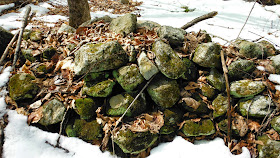I don't think I ever posted these photos from March 2014:

There's a Bear Up There:
It's up there, the Bear. If you follow the little brooklet up from the floodplain, here where the remnants of the zigzag rows of culturally stacked stones that border the riparian zone of both sides of the water feature disappear, south of the farm path across the stream, a little historic feature composed of cobbles tossed to fill the soggy spot, make a cart path, a little sort of causeway.
The edges are simple rows of cobbles...

Maybe this is another - I don't really know:
"ABOUT a mile north of the village of
Old Saybrook, on the road to Essex, is a spot known as"Obed's
Heights," from which no finer view in the valley of the Connecticut is to
be found. One looks down upon the woods, with the shadows and sunlight falling
upon them, and the peaceful Connecticut, far to the north, quietly flowing in
and out among the low-lying hills and ever broadening as it flows until it is
lost in the Sound. Lying far below to the south, the village of Old Saybrook,
with its quiet streets and grand old elms; beyond, the settlement of Fenwick,
and then the shining waters of the sound that are ever darkening and changing.
At the foot of
the "heights," among the pines, is a broad tablelike rock known as
"Obed's Altar." The Indian chief. Obed, was the son of a Hammonasset
chief. After the Pequots were subdued, he accepted a lowly position among the
whites. The Saybrook records mention Obed as a servant to Colonel Fenwick, who
gave him a piece of land to the west of the mouth of the river, known as
"Obed's Homok." Later he owned fields above the village, and it was
near the rock mentioned he built his wigwam...
Parson Buckingham talked frequently
with Obed and tried to show him the true way to receive pardon, and urged him
to turn to the God of his daughter and the white man. One day Obed told Parson
Buckingham he desired to accept his God. Never again was smoke seen rising from
the altar, for on the next morning Obed was found lying dead upon the rock
where he had offered his sacrifices." - 1905 Connecticut Magazine article
And, back to that hillside I started to tell you about, there's a possible deer nearby on another boulder:
Gladys Tantaquidgeon wrote about bear, deer, and sacrificing tobacco in "Folk Medicine of the Delaware and Related Algonkian Indians (1972, 1995)"
(pg. 60):
"Wild animals, as pointed out by F.G. Speck (1931: 28-29), are
in general considered to exist in clan relationship with humans. The latter are
said to be "kings among animals." Clean pure animals of the forest
are referred to in terms of human relationship and their spirits must be
propitiated before they can be sought for food. If the supernaturals are
appeased through sacrifices, the animals will allow themselves to be taken, but
if the proper ceremonies are not carried out, they can never be approached by
humans.
Therefore, a hunter is obliged to pray and sacrifice tobacco before
starting on the hunt... The Delaware consider the bear and deer to be the
greatest of all animals. The bear is also called "Our Grandfather."
Both animals are considered closely akin to the Indian, but the Delaware
believe that the bear has the most human-like traits..."
And there are also some low "mounds" - Sacred Stones-
Manitou Quassuk:
Branching off to the west is a linear stone row, an interesting boulder that could suggest a snake or serpent head as it's End Stone:
Some quartz in that row of mostly cobbles:
Above, the quartz could be said to resemble and represent a turtle head, the slender curved stone beside it could be interpreted as the extended left foreleg and the thin stone between the suggested head the nuchal notch in the marginal scutes below:
(It occurred to me that day that it was if it was like a little stone heap that could have been added to an already existing row of stones, possibly the work of a single person perhaps...
The row disappears near the trail, but two more rows meet close by,
perhaps a "qusukqaniyutôk (‘stone row, enclosure’ Harris and Robinson, 2015:140, ‘fence that crosses back’ viz. qussuk, ‘stone,’ Nipmuc or quski, quskaca, ‘returning, crosses over,’ qaqi, ‘runs,’ pumiyotôk, ‘fence, wall,’ Mohegan, Mohegan Nation 2004:145, 95, 129) define spaces, while świhwákuwi (viz. świk+wāgawi, ‘it grows around,’ Unami Lenapeuw, Zeisberger 1995:151, 173:"
Farther down the trail, in the east/west row of stones almost four feet tall, another interesting piece of quartzite:





























No comments:
Post a Comment